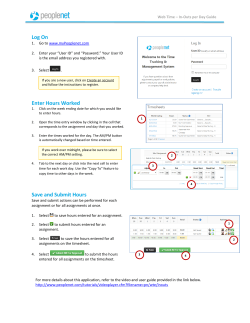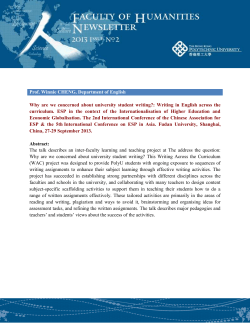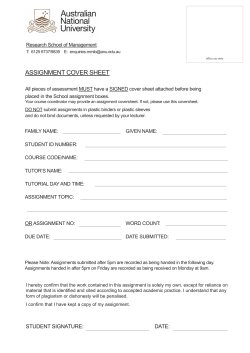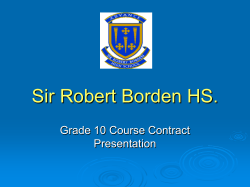
MAT347: Groups, Rings, and Fields. Logistics
MAT347: Groups, Rings, and Fields. Course syllabus. University of Toronto. Academic year 2014–2015 Logistics • Instructor: Alfonso Gracia–Saz (alfonso@math.toronto.edu). • Office: HU 1016. (To get there, go to 215 Huron St, take the elevator to the 9th floor, then the stairs to the 10th floor, and then find room 1016. If you have reduced movibility, please email me and we will arrange a meeting somewhere else.) Tel: 416978-0693. • Office Hours: See course website. • TA: Jonathan Love (jonathan.love@mail.utoronto.ca) • Class schedule: Mon 11-12, Wed 11-12, Fri 10-12. All four hours are equally important. • Location: WI 1017 (Mon in the Fall), ES B149 (Wed and Fri in the Fall), RW 117 (Winter). • Textbook: Dummit and Foote, Abstract algebra, Wiley. 3rd edition. • Our platforms: 1. All official information will be posted on the course website: http://uoft.me/MAT347 Please check the course website regularly to learn what we are doing each week and to get each homework assignment. 2. We will post grades on blackboard. 3. We will use Piazza as an online forum for you to ask and answer questions. See link on course website. • Deadline to drop this course: February 16. • Prerequisites: The calendar lists MAT 257 (and hence indirectly MAT157, MAT240, and MAT247) as prerequisites, and I will assume you have taken these courses. Specifically, in terms on content, you need to be perfectly comfortable with abstract linear algebra (that is, over arbitrary fields, including finite fields) and with complex numbers. However, more important than having learned any piece of content, the prerequisites are there to guarantee that you are comfortable with abstract reasoning and proof techniques, and that you understand how to write and read mathematics. If you are uncertain of whether you have the necessary prerequisites, talk to me. • Accesibility Needs: If you require accommodations for a disability, or have any accessibility concerns about the course, the classroom or course materials, please contact Accessibility Services as soon as possible: disability.services@utoronto.ca or http://studentlife.utoronto.ca/accessibility . 1 Content objectives of the course This course will provide a detailed introduction to modern abstract algebra, which is a basic part of the language of much of modern mathematics. Consider the following questions: • You probably know how to construct a regular hexagon with straigh edge and compass, but for which values of n is a regular n-gon constructible? For instance, a regular heptagon is impossible to construct, but a regular 17-gon is constructible. • You are familiar with the quadratic formula that allows us to solve the equation ax2 + bx + c = 0 using radicals. There is a similar formula for cubic and quartic equations, but it is impossible to find such a formula for quintic equations. Even more, it is impossible to write down the solutions to the equation x5 − 6x + 3 = 0 explicitly in terms of the four basic operations, rational numbers, and n-th roots. Why? 2 • You may have heard that the function F (x) = 0x et dt is trascendental. In other words, 2 we cannot write an antiderivate of f (x) = ex in terms of “elementary functions” (i.e. as composition of rational functions, radicals, trig functions, exponentials, and logarithms). You also may have heard that the differential equation y 00 +xy = 0 cannot be solved in terms of elementary functions and antiderivatives. How do we prove these statements? R The answers to all these problems lie in Galois theory, one of the most beautiful gems of mathematics that you will learn as an undergraduate (which Galois developed at the age of 17, four years before dying on a duel), and the ultimate goal of this course. To get there, first we need to develop a lot of background: group theory (first term), and rings and fields (second term). By the end of the course we will have solved problems 1 and 2 and you will have an idea of how problem 3 could be attacked. The path is long, but the reward at the end of the way is well worth it. Course structure • Book chapters. We will mostly cover material from Chapters 0–5, 7–9, 13–14. Occasionally I may introduce some material not in the book. If this is significant, I will state so. • Classroom time. All four hours of class time are equally important. Do not think of them as three hours of lecture plus one hour of tutorial. One of the objectives of the course is to continue your transformation from students to mathematicians. You will accomplish this not by merely watching me do mathematics, but by doing lots of math yourselves. Hence there will be important parts of the course, including big theorems, that you will be responsible for proving yourself. This includes some class time. 2 The textbook has more space than we have class meeting time. I prefer to spend class time motivating difficult concepts or elaborating on harder examples or guiding you to construct your own proofs rather than writing the details of an easy proof that is found in the book and that you could reconstruct on your own. • Reading. There will be roughly weekly reading assignments from the textbook, corresponding to the material that we are covering. Even if we do not complete all details in class, I still expect you to read the entirety of each chapter and to understand it, in addition to class notes. In other words, everything is equally important, and everything prepares you equally well for the tests. I am happy to go over any details with you during office hours. • Homework. There will be roughly weekly homework assignments that I ask you to complete. The assignments are long, but you are only required to turn in a small number of problems each week, which will be marked. I choose problems that will help solidify the concepts and that will help you understand the subsequent lectures. Because of that, it is important that you do all of the assigned problems, including the ones not to be turned it, and I will assume you have. This is particularly relevant for exams. I will not accept late assignments. This course is unforgiving if you fall behind, so I do not want to encourage it. The lowest three scores will be dropped for every student. We will post the homework assignments on the course website and grades on blackboard. • Midterms. There will be two midterms, tentatively on October 31 and February 13. I will announce the exact dates and the test structure in class and on the course website. • Project. There will be a project due in December, which consists of classifying all groups of a certain order up to isomorphism. I have designed this project to give you a taste of what research is like. As a warning, past students who completed this project spent a very large number of hours working on it, but many claimed it was their favourite part of the course and a great learning experience. You will need to and produce a written paper in LATEXwith your results. I will post more information, including help to learn LATEX, on the website. • A word of caution. Even though it may seem like we start slowly, we will pick up the pace, and I guarantee you you will be doomed if you fall behind. That would be a pity as the final part of this course is pure beauty. Evaluation The final mark will consist of homework (13%), project (18%), two midterms (18% each), and final exam (33%). 3
© Copyright 2025





















